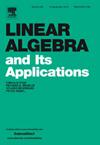Vertex partitioning and p-energy of graphs
IF 1.1
3区 数学
Q1 MATHEMATICS
引用次数: 0
Abstract
For a Hermitian matrix A of order n with eigenvalues , define to be the positive and the negative p-energy of A, respectively. In this note, first we show that if , where are square matrices, then for any real number . We then apply the previous inequalities to establish lower bounds for p-energy of the adjacency matrix of graphs.
图的顶点划分与p-能
对于特征值λ1(a)≥⋯≥λn(a)的n阶厄米矩阵a,定义Ep+(a)=∑λi>0λip(a),Ep−(a)=∑λi<0|λi(a)|p,分别为a的正p能和负p能。本文首先证明了如果A=[Aij]i,j=1k,其中Aii为方阵,则Ep+(A)≥∑i=1kEp+(Aii),Ep−(A)≥∑i=1kEp−(Aii),对于任意实数p≥1。然后,我们应用前面的不等式来建立图的邻接矩阵的p能量的下界。
本文章由计算机程序翻译,如有差异,请以英文原文为准。
求助全文
约1分钟内获得全文
求助全文
来源期刊
CiteScore
2.20
自引率
9.10%
发文量
333
审稿时长
13.8 months
期刊介绍:
Linear Algebra and its Applications publishes articles that contribute new information or new insights to matrix theory and finite dimensional linear algebra in their algebraic, arithmetic, combinatorial, geometric, or numerical aspects. It also publishes articles that give significant applications of matrix theory or linear algebra to other branches of mathematics and to other sciences. Articles that provide new information or perspectives on the historical development of matrix theory and linear algebra are also welcome. Expository articles which can serve as an introduction to a subject for workers in related areas and which bring one to the frontiers of research are encouraged. Reviews of books are published occasionally as are conference reports that provide an historical record of major meetings on matrix theory and linear algebra.

 求助内容:
求助内容: 应助结果提醒方式:
应助结果提醒方式:


